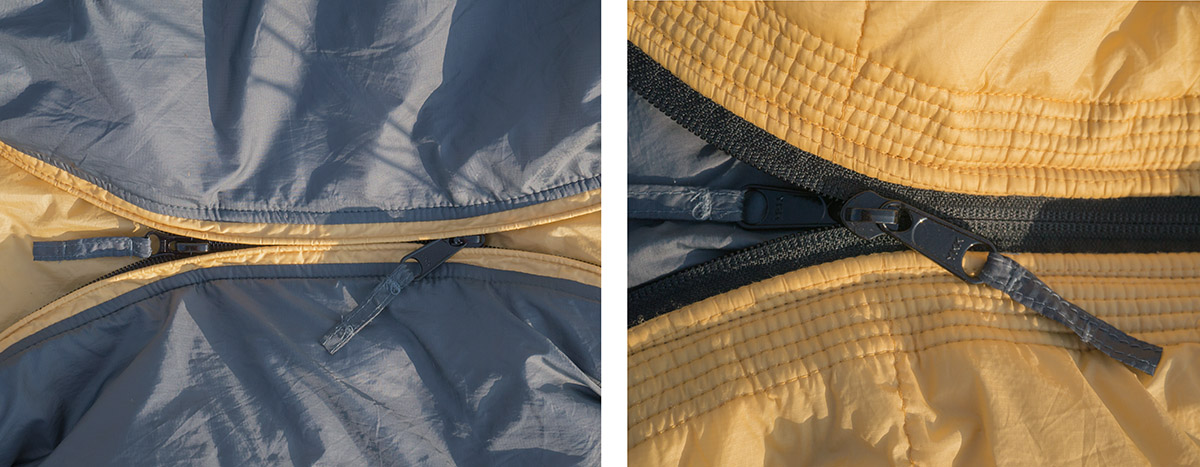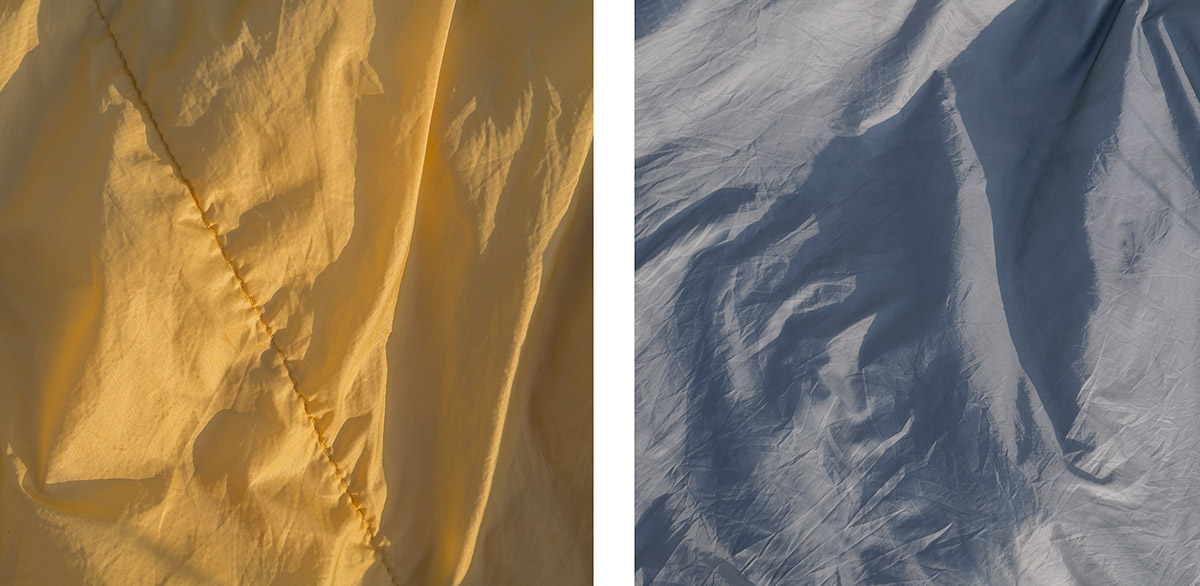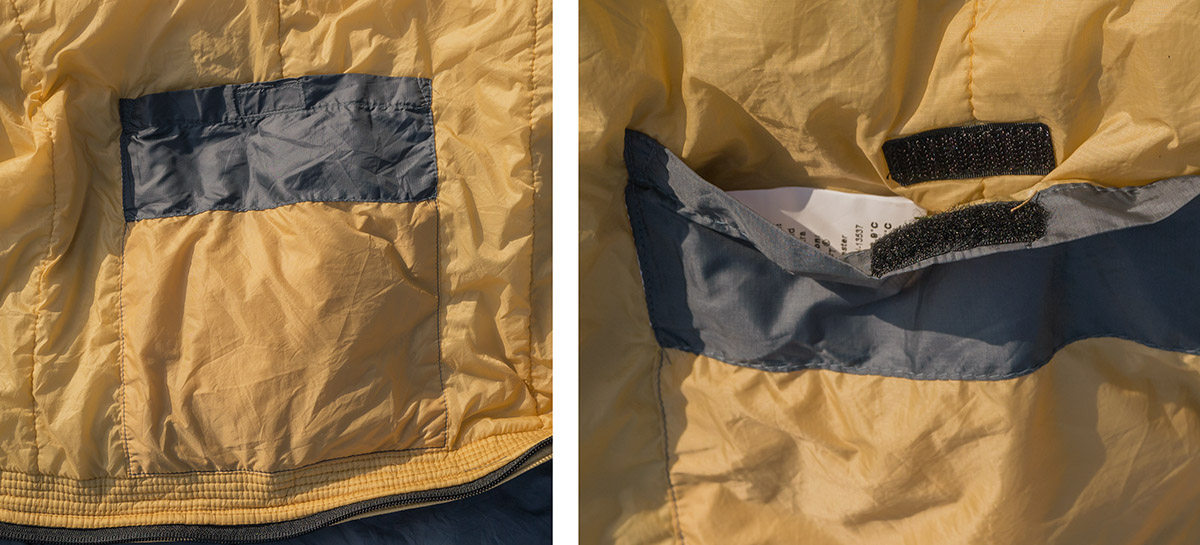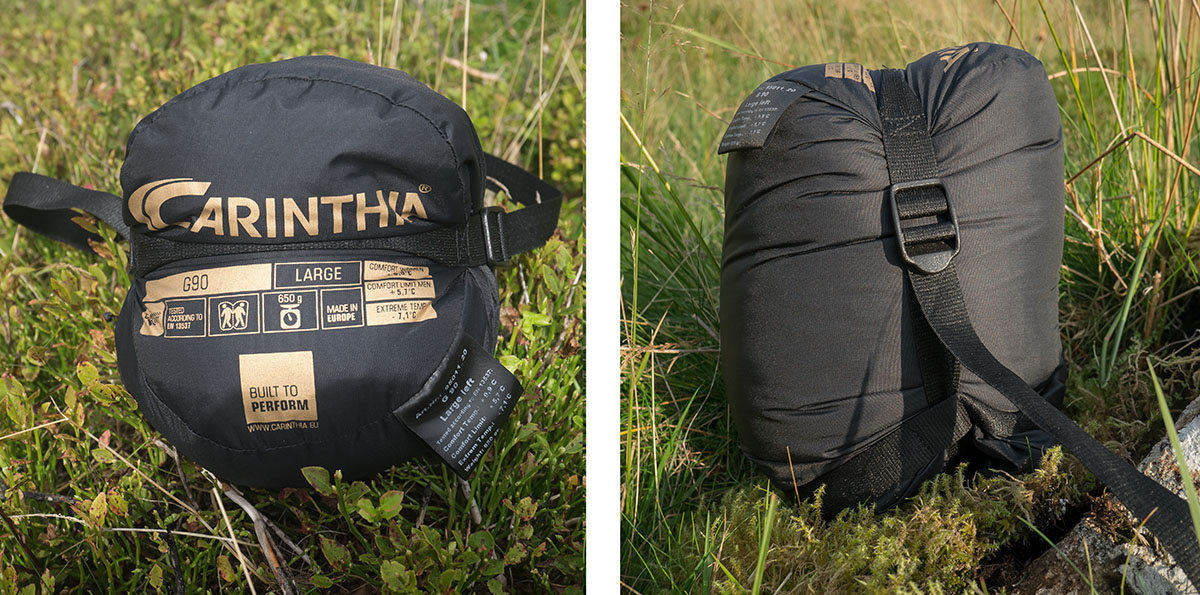Carinthia's G-90 Sleeping Bag (L)
Preface
The following assumes the use of a tent or hooped bivvy (hammock and or tarp / non-hooped bivvy users will need to decide whether such a system may benefit them).
A great deal of testing in varied conditions has brought us to recommending this "modular system". However, more than perhaps any other item, sleeping bags and their worth seems a very personal matter. Everyone's metabolism is different, some sleep hot, some cold, some on their side, some on their back, some probably sleep upside down ... who knows.
All we can do here is recommend what works for us and in doing so provide some useful information to consider before spending what can be a considerable amount of money and often the largest budget item(s) in any pack.
We also assume some sensible sleepwear and this combination has been tested with the thermal underwear recommended in our "sleepwear section" (we do not assume the wearing of insulated jackets or over-trousers).
The combination of sleeping bags we recommend are intended to work together enabling their user to carry only what is likely to be necessary for each trip. This combination will work from the arid to the tropical and down into frostbite territory. It uses a mix of synthetic and down insulation, with the down bag always on the inside (except in conditions where warm dry weather is predictable and persistent).
This system will not be too relevant to those who venture out only when it's a nice day; but will likely be of interest to those who enjoy the challenge of enduring the unpleasant conditions that hostile environments visit upon them.
Test subject: Chest 42", Waist 33", Height: 5ft 8"
Test item: 2020 Release, Size L (230 cm)
Kit Tests: Summer
Disclaimer: None required (item not provided by manufacturer)
Datasheet
| Outer Material: Shelltex Ultra Pro [Polyamide (Nylon)] | 100% |
| Inner Material: Shelltex Superlight Pro [Polyamide (Nylon)] | 100% |
| Insulation: G-LOFT (Hollofibre Polyester) | 90 gsm |
| Dimensions (L / 230): Length / Width top / Width bottom | 230 / 83 / 55 cm |
| Weight (L / 230) w/o stuff sack +62g (2.3 oz), stated / measured | ~650g / 694g (22.9 oz / 24.5 oz) |
| Temperature specifications according to EN 13537 (Comfort Limit / Extreme) | 5.7 °C (42.3 °F) / -7.1 °C (19.2 °F) |
| Pack size | 14 x 20 cm |
| Manufacturer RRP (priced in Euro = 229.90) | ~ £200.00 |
Scramble Review
Contents
- Introduction: Still A Hard Find
- Carbon-Based Inflation
- Features
- Materials
- Inside Out: Pockets & Pack Size
- In Context: Scramble's Recommended Sleeping Bag System
- Budget Alternatives to the Carinthia G-90
- Any Negatives?
- Conclusion, Rating & Product Images
Introduction: Still A Hard Find
"Jungle Bag and 3 Season Outer"
Of the three sleeping bags we recommend as part of our modular system, the hardest to source has been the one under review here: the warm and wet weather "jungle bag and 3 season outer". Finding a synthetic fill sleeping bag that is spacious enough to avoid compressing (and thus quashing the thermal effectiveness of) the down inner bag, while remaining light enough for mountain use is not easy. Most non-mummy bags the industry has to offer tend to be designed for people with caravans or family tents the size of caravans and such folk tend not to count each and every gram.
Unlike our previous (now discontinued) almond-shaped recommendation, the Nordisk Abel +10, the Carinthia G-90 is a mummy-bag (in Carinthian style), but rather like its sub-zero conscripted brother (the Defence 4) it's an accommodating mummy.
 Carinthia's G-90 looking rather unspectacular with hood un-cinched.
Carinthia's G-90 looking rather unspectacular with hood un-cinched.
Where Size Really Does Matter
The G-90 comes in two sizes: M and L. For our purposes, we're only interested in the G-90 size L, and the key dimension, that for us rules out the smaller size, is the width across the shoulders. If we were looking at this bag as a stand-alone, the length of the bag would be the dominant factor, but this bag in colder seasons will be home to a down inner bag, so width is key.
Note / Caveat: We're recommending the G-90 size large for everyone (at least everyone interested in using it as a modular bag), regardless of their height, because the width in the medium size is too narrow for our purposes (however this may not be the case for petite types with narrow shoulders), The extra space for people under 6ft is really a bonus as the shorter user will get more width at their feet. When used with another bag in sub-zero conditions, the additional space is very handy for storing boots or other bagged, wet items you want to keep from icing up.
Comparison to Nordisk Abel +10
For a little more context regarding how the two lighter bags in our modular sleep system combine and the thought behind it, we recommend a quick scan of the archived Abel +10 review.
The Carintha G-90 (L) is a wide mummy bag with a gentle, non-aggressive taper (similar to the Defence 4). The Abel +10 was an egg/almond shape with a more aggressive taper from below the knee.
A few points to note:
- The Abel +10 came in two sizes (L and XL), the Large G-90 equates to a cross between the L and XL Abel +10.
- The G-90 (L) is the same length as the Abel XL (230cm) and nearly the same width (2cm narrower at 83cm) as the Abel L (85cm) with a footbox 5cm wider (at 55cm) than both Abel +10 models (50cm).
- Because width is one of the central issues, we'll compare the width of the G-90 (L) to the Abel +10 (L) and its length to the Abel +10 (XL) and we'll compare its weight to the average of the two Abel+10 models, both stated and measured (as our Nordisk Abel+10 came in lower whereas our Carinthia G-90 came in heavier than stated, so the measured weights are likely more reliable than the stated ones).
Let's set out the comparison:
| Measure | Abel +10 | G-90 (L) |
| Width (shoulders / footbox): | 85cm / 50cm (L) | 83cm / 55cm |
| Length: | 230cm (XL) | 230cm |
| Weight (measured without stuff sack): | 777g (Avg: L/XL) | 694g |
| Temperature Comfort Limit (EN 13537): | 10 °C (50 °F) | 5.7 °C (42.3 °F) |
* EN 13537 "Comfort Limit" : A "standard man" with curled up posture is close to feeling cold but is "not feeling cold")
So in comparison to our Abel +10 synthesis, the G-90 is:
- Length: the same length (at 230cm)
- Width: 2 cm narrower at the shoulders, 5 cm wider at the feet
- Weight: 83g lighter (86g lighter if you include the stuff sacks, the Carinthia G-90 stuff sack is 62g versus 65g for the Nordisk Abel +10)
- Warmth: 4.3 °C (7.7 °F) warmer.
So, in summary you get a similarly sized bag (that will fit all but the very tallest among us) that is in the range of 100g lighter and 4 °C warmer. The G-90, part of Carinthia's "pro" range, has one of the best warmth to weight ratios of any synthetic bag and this comes with a not insignificant price tag.
 Carinthia's G-90 with its hood cinched up resembles the high end UL bag it actually is.
Carinthia's G-90 with its hood cinched up resembles the high end UL bag it actually is.
There are a few items that we regard as investments; quality items should provide many (5 to 10) years of use and thus their cost is carried over time. In the "investment" category, we include boots, tents, backpacks and sleeping bags.
The G-90 brings down the carry weight of what was already an excellent system and extends it deeper into the extreme sub zero range.
For those of a dogmatic and/or sensitive disposition, you may want to skip the next section and jump straight into the G-90, otherwise read on ...
[ Rant Ahead ] Carbon-Based Inflation (Or How To Make Sleeping Bags Out Of Electricity)
The globe has witnessed a couple of bouts of economic self-harm recently (locking down the world's productive workforces and decimating the global logistics infrastructure during COVID-19 and escalating a peculiar war on carbon). At Scramble, we're all aboard the (genuine) environmental bandwagon and personally I'd put my environmental credentials up against any virtue-signalling outdoor brand CEO or the vast majority of the population (including Greta Thunberg) for that matter. But carbon (and water of which we largely comprise) and carbon dioxide, which if I remember from my biology classes, is what plants (carbohydrates) need to grow, are really not the problem.
Pollution (largely toxic chemicals from heavy industry, industrial agriculture, the pharmaceutical industry and the military etc ...) is the problem and it's poisoning us and wounding the planet, but Mark Carney hasn't worked out how to make a market from cleaning up after his friends, so we're left with carbon indulgences and Greta-style end-of-world scientism.
Now, why have I ranted myself into such a tangential cul-de-sac in the middle of a sleeping bag review? Well, sleeping bags (especially synthetic ones) are almost entirely a by-product of the petrochemical (fossil fuel) industry. Unless people work out how to make sleeping bags out of electricity, the actions of these virtue-signalling despots who are shepherding us into a feudal future, will see sleeping bags and all outdoor apparel sky-rocket. To wit, the made in Europe, Carinthia G-90's RRP just jumped from around £160 to £205 (after duties. Carinthia have it at 230 euros, so it should be more like £192 at current exchange rates).
The G-90: Main Features
So, we've established the G-90 is something of a premium product (at least as far as its price tag), but is it worth it? We think it is, but as there's a very major price jump from our previous (now discontinued) recommendation, we're going to keep looking for more budget-friendly alternatives and when we find them, we'll add them to this section.
So let's get back to the G-90 and see if it can live up to its price tag. We'll start at the head and work our way down and we'll keep this section brief and snappy as, in terms of features, the G-90 can be quite accurately viewed as an ultralight version of the better-known Defence 4.
The Hood
The hood is classic Carinthia; from wide open and somewhat flaccid and characterless (below left) to a sleeping bag's best attempt at Edward Munch's "The Scream" (below right) . The hood has a pretty standard dual cinch, so the shoulder or hood can be cinched independently. The cord and cord lock is of a higher quality than most. When fully cinched, just ones face is exposed and the bag does an excellent job at preventing warm air escaping.
 Independent cinching for the hood and shoulders.
Independent cinching for the hood and shoulders.
The Zip
Above the shoulders on the left side is the full length zip and its very important velcro flap closure. The G-90, like the Defence 4, has the best non-snagging zips of any sleeping bags we've tested. Though this should be (and really is) a very good thing, on the G-90 they glide so freely that when I was getting acquainted with the bag, I kept finding, as I was wriggling around adjusting and settling in, the zip, under pressure, would just unzip itself. It soon became clear how essential the velcro flap was. Once the velcro is mated (pic #1 below), the zip remains set in place.
Should anyone wish to not lock themselves in, say in very hot conditions when you barely want a sleeping bag at all, the velcro closure flap can be folded onto itself (pic #3), leaving the zip easily accessible to the sleeper.
 Carinthia's G-90 has such non-snagging zips that the velcro zip flap works as an important locking mechanism.
Carinthia's G-90 has such non-snagging zips that the velcro zip flap works as an important locking mechanism.
The zip runs from the shoulder to the footbox and is a dual-opening zipper, meaning you can open it from either end. A nice feature on hot nights when you want to cool down a little but still stay snug or you need to go for a wander but would rather take the bag with you. The zips can be accessed from the inside as well as the outside of the bag.
 The zips can be accessed from inside and out and open from the footbox and / or the shoulder.
The zips can be accessed from inside and out and open from the footbox and / or the shoulder.
The Footbox
The G-90 has a wider (55cm) footbox than many mummy bags and this makes it an excellent host for ultralight down quilts and sleeping bags. Furthermore, this version of the G-90 is 230cm long and so people like me who fall some way short of the 6ft mark will have even more space to flap their feet. This extra space can come in quite handy when temperatures drop below zero for storing damp clothing and footwear to prevent them freezing overnight.
The footbox features Carinthia's standard hanging loops for drying out the bag when the sun finally arrives.
 The G-90 has a wider than average footbox at 55cm and features two hanging loops for drying the bag.
The G-90 has a wider than average footbox at 55cm and features two hanging loops for drying the bag.
Materials
The G-90 uses Carinthia's proprietary G-Loft "hollowfiber" synthetic fill, manufactured in-house (in Austria). It's very compressible, has an excellent warmth-weight ratio and is also moisture resistant, meaning that it will work even under long term use in damp conditions. G-Loft filling has a memory effect and once released from its stuff sack and shaken vigourously, lofts quickly.
The G-Loft insulation contains Carinthia's Thermoflect, a very thin, very lightweight aluminium material which reflects body heat. Carinthia state that Thermoflect raises the sleeping bag's heat-retaining capacity by around 11%. Though it's hard to substantiate that claim, what is clear is that the G-90, for a synthetic, has an impressive warmth to weight ratio.
 The Carinthia G-90's outer made from Shelltex Ultra Pro, a non-stitched, water-resistant, heat-trapping outer made from a light, tightly woven polyamide.
The Carinthia G-90's outer made from Shelltex Ultra Pro, a non-stitched, water-resistant, heat-trapping outer made from a light, tightly woven polyamide.
The outer fabric is a 100% polyamide (nylon), water-repellent material called Shelltex Ultra Pro. Carinthia's unique manufacturing process allows them to avoid stitching through the outer material. Preventing warm air leaking through stitched baffles gives Caranthia a competitive advantage in the synthetic weight game.
The Shelltex Ultra Pro's water-resistance makes it an excellent protective outer bag for down inserts when used as a modular bag but also an excellent bag for bivvying in very wet / saturated environments where condensation can be a major issue.
The inner lining is comprised of another, though much lighter and softer nylon which Carinthia call Shelltex Superlight Pro. Rather than trapping the heat like the outer, the lining is breathable and allows the body's warmth to enter the G-90's G-Loft insulation where it's largely trapped. Only on the inside, where it's far less critical and possible advantageous, do we see stitching; Carinthia certainly know what they're doing.
 The Carinthia G-90's comfortable Shelltex Superlight Pro inner (left) and water-resistant Shelltex Ultra Pro outer (right).
The Carinthia G-90's comfortable Shelltex Superlight Pro inner (left) and water-resistant Shelltex Ultra Pro outer (right).
Dimensions, Warmth & Weight In context
When we talk about standard narrow mummy bags, Mountain Equipment always provide good bench-marking examples for reference purposes. Two such synthetic bags (both with similar 5°C comfort limits), are the Lunar Micro 1 and the Starlight 1. Both are substantially heavier than the G-90, but more importantly they are both only 75cm at the shoulders. These kind of bags, which are representative of the vast bulk of sleeping bags on the market, cannot be used as an outer (housing an inner down quilt) in a modular sleep system. It's a slightly unfair comparison, as the G-90 is a more premium product and it's aimed at a slightly different user (people like us, perhaps).
Inside Out: Pockets & Pack Size
We've covered pretty much everything in terms of features. When we turn the bag inside out, we can find one more hidden secret.
 Carinthia's G-90 turned inside-out to reveal its internal pocket.
Carinthia's G-90 turned inside-out to reveal its internal pocket.
Internal Pocket
The G-90 has a large non-zipped internal pocket. I only occasionally use these pockets, but this is perhaps one area that could be improved. I understand why Carinthia shied away from using a zip, as these can cause irritation and they probably were also conscious of keeping the weight to a minimum. However, they perhaps could have used a longer velcro strip, as the pocket, though nicely sized, is not secure enough and for someone tossing and turning, a small torch or whatever small item one chooses to sleep with, can too easily fall out.
 Carinthia's G-90 has a less than secure inner pocket that would have benefitted from a more generous strip of velcro.
Carinthia's G-90 has a less than secure inner pocket that would have benefitted from a more generous strip of velcro.
Stuffed
The G-90 comes with a pretty standard but nonetheless high quality compression sack which weighs in at a respectable 62g. The G-90 size L, packs down to around 14 x 20cm.
 Carinthia's G-Loft insulation compresses well and the G-90 doesn't take up too much space in the pack.
Carinthia's G-Loft insulation compresses well and the G-90 doesn't take up too much space in the pack.
In Context: Scramble's Recommended Sleeping Bag System
The military modular system uses 2 bags: a lighter "patrol" bag (down to 0°C) and a medium-weight cold weather bag (down to -15°C) which combine for extreme cold (down to -30°C, but a total weight of nearly 3kg). Scramble's recommended "modular" system uses 3 bags, is lighter and more flexible (better in hotter, arid conditions, yet still good down to -20°C and likely -25°C, the extreme combination weighing just over 2kg).
In essence the G-90 and Alpkit's Cloud Cover combined are equivalent to the "patrol bag". As a rough comparison, Carinthia's Tropen is one such patrol bag, and is designed to fit inside the Defence 4. It weighs 1100g (M) or 1300g (L) and has a comfort limit of +5°C. The G-90 / Cloud Cover combo is equal to the medium Tropen in terms of weight and the large Tropen in terms of dimensions, yet from our test looks around 9°C warmer. In addition, these bags can function on their own, so in summer you're either carrying just 450g (650g/850g lighter) or in wet conditions 650g (stated weight), so 450g/650g lighter.
Another interesting comparison is with Mountain Equipment's Aurora I, which has a similar comfort limit (-2°C instead of around -5°C) and weighs in at just under 1100g. Again, the same inflexible logic applies, the ME bag would be too hot and too heavy for summer use, so a summer weight bag would also be required, but that summer bag wouldn't pair with the Aurora for -10°C and below, so an expensive winter bag is also required ... and maybe that's why modularity has yet to dawn on the outdoor market, yet is favoured by a more pragmatic military sector?
Measured weights (without stuff sacks, see our note below*):
- Warm + Dry Weather: Alpkit Cloud Cover = 438g (stuff sack +14g)
- Warm + Wet Weather: Carinthia G-90 (L) = 694g (stuff sack +62g)
- Spring + Autumn: Cloud Cover + Carinthia G-90 (L) = 1,132g
- Winter: Carinthia Defence 4 (M) = 1,650g (stuff sack +209g)
- Extreme Cold: Defence 4 (M) + Cloud Cover = 2,088g (stuff sack = Osprey Ultralight Pack Liner, Small, 30 - 50L = 78g).
Budget Alternatives to the Carinthia G-90
At present the best budget alternative we've found is:
- Nordisk's Puk +4° Egg
Similar to the Abel +10 in terms of design but substantially heavier than Carinthia's G-90 (stated weights = 890g vs G-90's 650g = 240g), though it should also be a fraction warmer (4.0°C vs G-90's 5.7° EN 13537 = 1.7°C). However, it's also a hell of a lot cheaper (Nordisk UK have it at 70 GBP).
Any Negatives?
The G-90 (L) is about as ideal as I think we're going to get for a modular summer bag and 3 season outer. However, as noted this comes at a relatively steep price rise compared to our previous recommendation, which was an incredible bargain for what it was.
So, one negative has to be the price. Everyone knows that quality ultralight gear gets pricey, but at around £190 - £200 full price, the G-90 is pushing it, and we've reflected this in our value rating score. As stated earlier, we're going to continue to supplement this review with related offerings that provide a more wallet-friendly option. However, I have to say the G-90 rounds off what is an excellent all-weather, flexible sleep system and even at full price for all the options, we're looking at around £500. Some will pay quite a bit more for a targeted (and thus far less flexible) single down bag (offering the same sub zero temperature rating).
The other minor negative is the somewhat insecure inside pocket. We've docked half a point here for function.
Conclusion & Rating
Carinthia are a rarity in the sleeping bag world. As we've stated before, there are many things one might wish to pack into a sleeping bag aside from ones own body. A sleeping bag offers sanctuary and a radiator for moist clothing to dry out over night, for wet boots that may freeze up. The obsession with dead-air and overly narrow mummy-bags is over-done in our opinion. By allowing some room to move and breathe Carinthia have made two great bags in the Defence 4 and the G-90, each at opposite ends of the spectrum in terms of weight and warmth, but each following the same design principle, making them ideal for outer bags in a modular system.
The G-90, like the Defence 4 provides excellent wind and water resistance due to its non-stitched outer shell. The inner is silky smooth and extremely comfortable. Sandwiched between these distinctly different nylons is Carinthia's polyester-based, aluminium-infused, G-Loft insulation, which seems to outperform many of the synthetic fills on the market. The G-90 has an outstanding warmth-to-weight ratio and is finished to Carinthia's usual high standard.
Whereas the Abel +10 was marketed (wrongly in our opinion) at the family camper and only accidentally appealed to the serious outdoor enthusiast, the G-90 is a very different, streamlined creature altogether, quite clearly targeted at people like us. It's no surprise that it comes from a manufacturer with one foot in the military camp, where modularity and the flexibility that accompanies it, have been embraced for some time. The rest of the outdoor market will one day catch up. Until they do, and perhaps long after they do, the Carinthia G-90 will likely epitomise the ideal lightweight, wet and warm weather solo bag and cold weather outer (to pair with a down inner like Alpkit's Cloud Cover or their Pipedream 200), taking us down into typical UK winter temperatures of around -4°C, -5°C.
The G-90 rounds off our sleep system perfectly and though it's a hefty price to pay, we feel the investment is worth it. So it's 2 out of 3 for Carinthia in our 3-bag system, with their G-90 our top pick in the "1 Season and 3 Season Outer" category.
Product Images
Rating (out of 10)
* The value score is derived from two factors:
1) Competitive Market Price (CMP). This represents our judgement of a competitive online price point if we were to stock the item. e.g. if we feel we would need to sell an item at 40% off (i.e. 60% of its full RRP) to be competitive, then our CMP score will be 6/10.
2) Customer Value Price (CVP). We then make an honest appraisal of the maximum price we would be willing to pay for the item (and we're mean). So if we'd pay 80% of its RRP our CVP score would be 8/10.
We then average the two scores to get our final value score, which in our example would be 7/10.
Postscript
Why not down all the way?
As an inner bag, down is superb. If you can guarantee arid conditions (deserts, Himalayas, arctic etc.) then down is the way to go, but for the UK and northern Europe, not so much and you literally have to factor in a daily thermal performance loss for down in wet conditions (regardless of hydrophobic patches to an insoluble problem).
Andy Kirkpatrick explains:
"There is nothing as great as a bone dry down sleeping bag. Unfortunately there is also nothing as grim as a wet one. Saturated down loses 90% of its insulation as the delicate structure of the clusters stick together and collapse. The down absorbs a lot of water and because it loses most of its thermal performance it must be dried via an outside heat source like the sun, a tumble dryer or a body. In many cases where there is moisture present, a down bag will lose performance each night it is used, as the down becomes slowly saturated. The rate at which this happens is dependent on the skill of the user and the conditions in which it is being used. This water contamination comes both from without and within the bag and learning to slow the speed of this performance drop is one of the skills needed to use a down bag effectively. Down just doesn’t work in high saturated environments and best suits cold and dry conditions, or the protected sanctuary of a dry space like a tent, hut or snow hole."
* A note on stuff sacks and weight stats
We don't quote the weights including stuff sacks, mainly because we don't feel the manufacturer's choice of stuff sack design has a great deal to do with their sleeping bags (an example is Mountain Hardwear's Lamina bags which come with something more akin to a Tesco's 10 gram shopping bag, whereas Carinthia's come with military grade compression sacks; apples and oranges and all that. In addition we only use a stuff sack for the sub-zero bag, and for that we use an Osprey Ultralight Pack Liner (S, 30 - 50L) The G-90 can simply go in the base of ones pack (assuming it has a waterproof liner) as it fills the nooks and crannies well and gets compressed by all your other kit. The Cloud Cover comes with a superlight sack and likewise easily gets compressed when you cover it with the rest of your stuff. If it's used as an inner, then it can just go inside the G-90 or the Defence 4.
Last Updated: 11/04/22





















